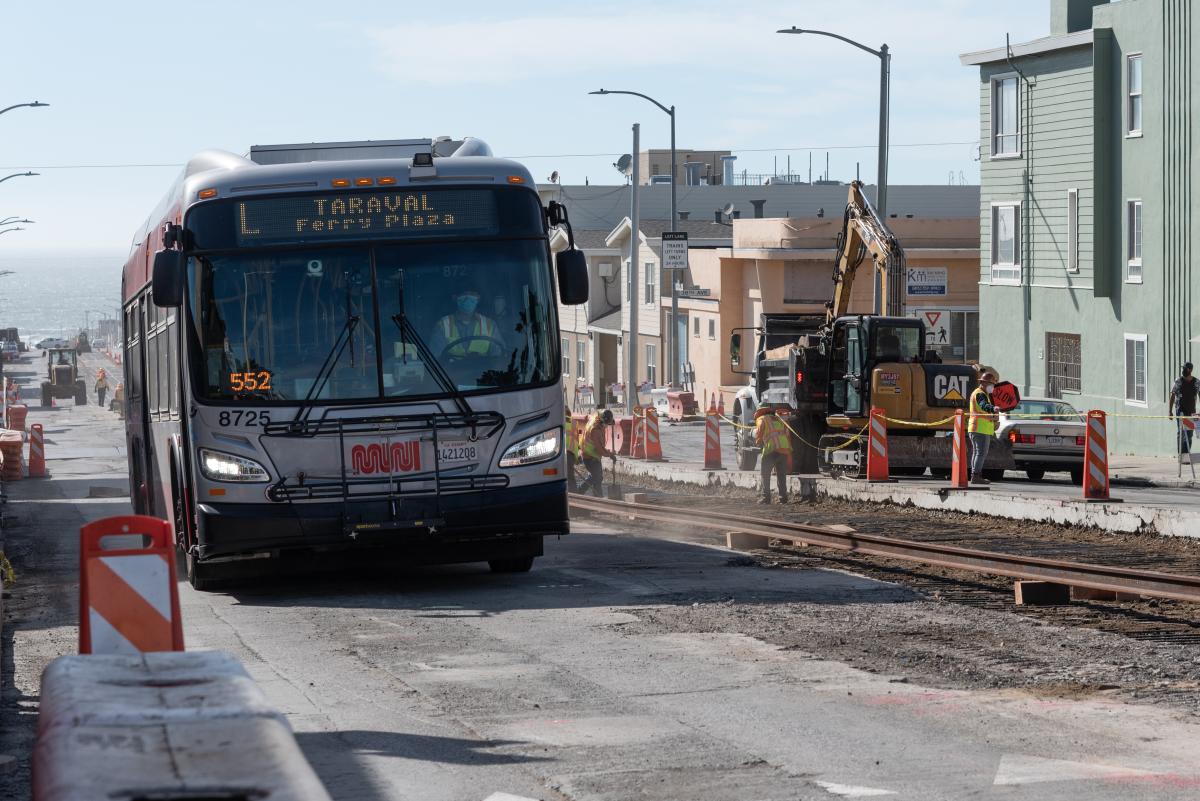 L Taraval Bus passing by construction for the L Taraval Improvement Project
L Taraval Bus passing by construction for the L Taraval Improvement Project
In these truly unprecedented times, the SFMTA has worked hard to sustain critical services and buy time for our revenues to recover before current federal relief funding runs out. But investments in our transportation infrastructure are needed to support reliable transit and safer streets. Two mayoral transportation community task forces over the last eight years (Transportation 2030 and Transportation 2045) have recommended a General Obligation (GO) Bond for transportation infrastructure. The city’s 10-Year Capital Plan calls for a Transportation GO bond on the June 2022 ballot.
The bond proposal focuses on top community priorities from the city's ConnectSF plan and SFMTA 2021 community survey. Priorities include keeping Muni equipment and facilities working efficiently, providing quick and convenient transit access, improving Muni service for communities that depend on transit, ensuring Muni service is inclusive and accessible to all and making street safety improvements for people walking and biking.
Proposed Bond Program Components
Make the Transportation System Work Better
- Speed up Muni repairs and keep public transit moving by repairing, upgrading and maintaining aging bus yards and equipment
- Enable faster, more reliable and more frequent Muni service by improving on-street infrastructure for public transit
- Increase subway capacity, reduce delays, and deliver dependable, high-frequency transit by modernizing the Muni train control system
Many Muni bus yards were built decades ago, with some over one hundred years old. While addressing all of SFMTA’s facility needs requires a variety of funding solutions, this proposed bond can fund high-priority needs. Upgrading bus maintenance yards allow us to repair Muni buses faster, preventing breakdowns and supporting reliable Muni service.
Street infrastructure improvements will help reduce travel times and delays for Muni. Tools include traffic signals that get buses through intersections quickly, wider sidewalks at bus stops for easier, more accessible boarding, and dedicated transit lanes to keep buses moving. When buses run faster and are not stuck in traffic, Muni can service more people with the same number of vehicles and drivers. This saves money that can be reinvested elsewhere in the system.
Our train control system is also over 20 years old. Replacing it will allow us to run longer trains to reduce crowding, increase speed in the subway and improve reliability for surface trains. These improvements can help Muni Metro become a modern rail system to better service our growing communities.
Improve Street Safety and Traffic Flow
- Improve safety and visibility at intersections by upgrading traffic signals, signage and crossings
- Increase the safety for walking and bicycling and access for Muni connections along major corridors by redesigning streets and sidewalks
- Slow speeds and reduce crashes by implementing traffic calming and speed reduction tools
The proposed bond can improve safety, accessibility and visibility for people walking and biking. Streets in historically disadvantaged communities are almost twice as likely to be on the High Injury Network, where we see the most deaths and serious injuries on our streets. The proposed bond includes funds to make strategic street safety and visibility improvements with an equity focus by prioritizing communities included in the Muni Service Equity Strategy with a high percentage of households with low incomes and people of color.
By funding larger, more visible traffic signals and pedestrian countdown signals, we can make intersections safer and work better for everyone, especially people with disabilities, older people and children. Redesigning streets with wider sidewalks, curb ramps, safer bikeways and traffic calming elements make streets safer and more accessible for all. These improvements are in support of the city’s Vision Zero policy goal to eliminate all traffic deaths in San Francisco.
Next Steps
Under-investment in transportation has been a decades-long trend. Visit our Transportation 2050 website for more information about SFMTA’s effort to chart a more sustainable course with your help. The GO Bond would provide a dedicated local funding source that can help meet San Francisco’s transportation needs.
The bond proposal will be presented for feedback at a number of public hearings including the SFMTA Citizens’ Advisory Council, the SFMTA Board Policy and Governance Committee, the SFMTA Board of Directors and the city’s Capital Planning Committee.
Comments are for the English version of this page.